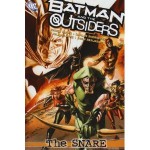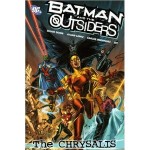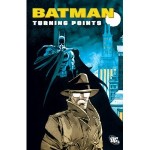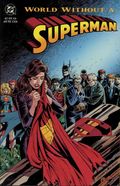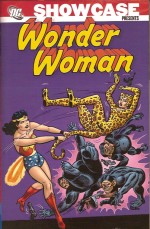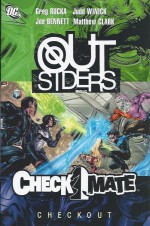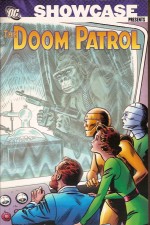
By Arnold Drake, Bruno Premiani, Bob Brown & various (DC Comics)
ISBN: 978-1-84856-218-9
1963 was the year when cautious comicbook publishers finally realised that superheroes were back in a big way and began reviving or creating a host of costumed characters to battle outrageous menaces and dastardly villains.
Thus it was that at National Comics venerable anthology-mystery title My Greatest Adventure dipped its toe in the waters with a radical take on the fad and introduced a startling squad of champions with their thematic roots still firmly planted in the B-movie monster films of the era that subtly informed the parent comic.
No traditional team of masked adventurers, the cast comprised a robot, a mummy and an occasional 50-foot woman, who joined forces with and were guided by a brusque, domineering, crippled mad scientist to fight injustice in a whole new way…
Covering June 1963 to February 1966, this first quirky monochrome compilation collects the Fabulous Freaks’ earliest exploits from My Greatest Adventure #80-85 and thereafter, issues #86-101 of the renamed title once overwhelming reader response compelled editor Murray Boltinoff to change it to the Doom Patrol.
The dramas were especially enhanced by the drawing skills of Italian cartoonist and classicist artist Giordano Bruno Premiani whose highly detailed, subtly humanistic illustration made even the strangest situation dauntingly authentic and grittily believable as with the premier tale ‘The Doom Patrol’ scripted by Arnold Drake and Bob Haney, which saw a mysterious wheelchair bound scientist summon three outcasts to his home promising to change their miserable lives forever.
Competitive car racer Cliff Steele had died in a horrific pile up, but his undamaged brain had been transplanted into a fantastic mechanical body. Test pilot Larry Trainor had been trapped in an experimental stratospheric plane and become permanently radioactive, with the dubious benefit of gaining a semi-sentient energy avatar which could escape his body to perform incredible stunts for up to a minute at a time.
To pass safely amongst men Trainor had to constantly wrap himself in special radiation-proof bandages.
Ex-movie star Rita Farr had been exposed to mysterious gases which gave her the unpredictable and, at first, uncontrolled ability to shrink or grow to incredible sizes.
These outcasts were brought together by brilliant but enigmatic Renaissance Man The Chief, who sought to mould the solitary misfits into a force for good and quickly proved his point when a mad bomber attempted to blow up the city docks. The wheelchair bound savant directed the trio of strangers in defusing it and no sooner had the freaks realised their true worth than they were on their first mission…
In the second chapter ‘The Challenge of the Timeless Commander’ an incredibly ancient menace tried to capture a fallen alien ship, intent on turning its extraterrestrial secrets into weapons of world conquest, culminating in ‘The Deadly Duel with General Immortus’ which saw the Doom Patrol dedicate their lives to saving humanity from all threats.
My Greatest Adventure #81, solely scripted by Drake, featured ‘The Nightmare Maker’ combining everyday disaster response – saving a damaged submarine – with a nationwide plague of monsters. Stuck at base, The Chief monitored missions by means of a TV camera attached to Robotman’s chest, and quickly deduced the uncanny secret of the beasts and their war criminal creator Josef Kreutz.
A clever espionage ploy outed the Chief – or at least his image, if not name – in #82’s ‘Three Against the Earth!’, leading the team to believe Rita a traitor. When the cabal of millionaires behind the scheme were revealed as an alien advance guard who assumed the wheelchair-bound leader to be a rival invader, the inevitable showdown nearly cost Cliff what remained of his life…
‘The Night Negative Man Went Berserk!’ in #83 spotlighted the living mummy when a radio astronomy experiment interrupted the Negative Man’s return to Larry Trainor’s body, pitching the pilot into a coma and sending the ebony energy creature on a global spree of destruction. Calamity piled upon calamity when crooks stole the military equipment constructed to destroy it and only desperate improvisation by Cliff and Rita allowed avatar and host to reunite…
Issue #84 saw ‘The Return of General Immortus’ as ancient Babylonian artefacts led the team to the eternal malefactor, only to have the wily warrior turn the tables and take control of Robotman. Even though his comrades saved him Immortus escaped with the greatest treasures of all time…
My Greatest Adventure #85 was the last issue and featured ‘The Furies from 4,000 Miles Below’, monstrous subterranean horrors fuelled by nuclear forces. Despite having tricked Elasti-Girl into resuming her Hollywood career, the paternalistic heroes were pretty grateful when she turned up to save them all from radioactive incineration…
An unqualified success, the comicbook transformed into The Doom Patrol with #86 and celebrated by introducing ‘The Brotherhood of Evil’, an assemblage of international criminals and terrorists led by French genius-in-a-jar The Brain and his greatest creation, a super-intelligent talking gorilla dubbed Monsieur Mallah. The diametrically opposed teams first crossed swords after brotherhood applicant Mr. Morden stole Rog, a giant robot the Chief intended for the US military…
DP #87 revealed ‘The Terrible Secret of Negative Man’ when Brotherhood femme fatale Madame Rouge tried to seduce Larry. When the Brain’s unstoppable mechanical army invaded the city, Trainor was forced to remove his bandages and allow his lethal radiations to disrupt their transmissions…
An occasional series of short solo adventures kicked off in this issue with ‘Robotman Fights Alone’, wherein Cliff was dispatched to a Pacific island in search of an escaped killer, only to walk into a devastating series of WWII Japanese booby-traps…
All the mysteries surrounding the team’s leader were finally revealed in issue #88 with ‘The Incredible Origin of the Chief’, a blistering drama which told how brilliant but impoverished student Niles Caulder received unlimited funding from an anonymous patron interested in his researches on extending life. Curiosity drove Caulder to track down his benefactor and he was horrified to discover the money came from the head of a criminal syndicate who claimed to be eons old…
Immortus had long ago consumed a potion which extended his life and wanted the student to recreate it now that the years were finally catching up. To insure Caulder’s full cooperation, the General had a bomb inserted in the researcher’s chest and powered by his heartbeat …
Building a robot surgeon, Caulder tricked Immortus into shooting him, determined to thwart the monster at all costs. Once clinically dead, his Ra-2 doctor removed the now-inert explosive and revived the bold scientist, but tragically the robot had been too slow and Caulder lost the use of his legs…
Undaunted, the Man Who Lived Twice then destroyed all his research and went into hiding for years, with Immortus unaware that Caulder had actually succeeded in the task which had stymied history’s greatest doctors and biologists…
Now, under the alias of super-thief The Baron, Immortus had captured the Doom Patrol and demanded a final confrontation with the Chief. Luckily the wheelchair-locked inventor was not only a biologist and robotics genius but also adept at building concealed weapons…
In #89 the team tackled a duplicitous scientist who had devised a means to transform himself into ‘The Animal-Vegetable-Mineral Menace’ and ‘The Private War of Elasti-Girl’ saw the Maid of Many Sizes use unsuspected detective skills to track down a missing soldier and reunite him with his adopted son before ‘The Enemy within the Doom Patrol’ saw shape-shifting Madame Rouge infiltrate the team and almost turn them against each other.
Issue #91 introduced multi-millionaire Steve Dayton who created a superhero persona solely to woo and wed Rita Farr. With such ambiguous motivations ‘Mento – the Man who Split the Doom Patrol’ was a radical character for the times, but at least his psycho-kinetic helmet proved a big help in defeating the plastic robots of grotesque alien invader Garguax…
DP #92 found the team confronted by a temporal terror in ‘The Sinister Secret of Dr. Tyme’ with the abrasive Mento again saving the day whilst ‘Showdown on Nightmare Road’ in #93 saw The Brain’s latest monstrous scheme result in the evil genius being planted inside Robotman’s skull and poor Cliff transplanted into a horrific beast, until the Chief out-played the French Fiend at his own game…
Bob Brown stepped in to illustrate #94’s lead feature ‘The Nightmare Fighters’ with an eastern mystic’s uncanny abilities swiftly debunked by solid American science but Premiani was around to render the solo-feature ‘The Chief “Stands†Alone’ wherein Caulder eschewed his deputies’ aid to bring down bird-themed villain The Claw with a mixture of wit, nerve and weaponised wheelchair.
When The Chief attempted to cure Rita and Larry in DP #95 it resulted in switched powers and the ‘Menace of the Turnabout Heroes’, so naturally that would be the very moment the Animal-Vegetable-Mineral Man would pick for a return bout, whilst in #96, on ‘The Day the World Went Mad!’, the Patrol’s frantic investigations revealed that the global wave of insanity was caused by a deadly alliance of the Brotherhood, Garguax and Immortus, which they were helpless to counteract…
In issue #97 that sinister syndicate attacked Earth by transforming innocent citizens into crystal, spectacularly resulting in ‘The War against the Mind Slaves’, the return of Mento and a stunning showdown on the moon, after which #98 saw both ‘The Death of the Doom Patrol’ – a grievous over-exaggeration on behalf of transmutational foe Mr. 103, who was actually compelled to save Caulder from radiation poisoning – and the Brown-drawn solo-thriller ’60 Sinister Seconds’ in which Negative Man had to find and make safe four atomic bombs in different countries within as minute…
Brown also handled both tales in Doom Patrol #99, starting with an old-fashioned battle against a deranged entomologist whose mechanical insects delivered ‘The Deadly Sting of the Bug Man’ and proceeding to the groundbreaking first appearance of shape-shifting juvenile delinquent ‘The Beast-Boy’ who burgled than saved the team with his incredible ability to become any animal he could imagine.
A vast extended storyline began with #100 and ‘The Fantastic Origin of Beast-Boy’ (illustrated by Premiani) wherein the obnoxious kid was revealed as orphan Gar Logan, a boy being slowly swindled out of his inheritance by his ruthless guardian Nicholas Galtry.
The conniving accountant had even leased his emerald-hued charge to scientist Dr. Weir for assorted experiments, but when the Patrol later tackled rampaging dinosaurs, the trail led to Gar who at last explained his uncanny powers.
Whilst in Africa as a toddler Logan had contracted a rare disease and his scientist father tried an experimental cure which left him the colour of cabbage but with the ability to change shape at will.
Now it appeared that Weir has used the lad’s altered biology to unlock the secrets of evolution… or had he?
Despite foiling the scheme the team have no choice but to return the boy to his guardian, but Rita is not prepared to leave the matter unresolved… The anniversary issue also saw the start of an extended multi-part thriller exploring Cliff’s early days after his accident and subsequent resurrection beginning with ‘Robotman… Wanted Dead or Alive’. Following Caulder’s implantation of Cliff’s brain into the mechanical body the shock drove the patient crazy and Steele went on a city wide rampage…
This first fantastic collection concludes with Doom Patrol #101 and the riotous romp ‘I, Kranus, Robot Emperor!’ wherein an apparently alien mechanoid had a far more terrestrial and terrifying origin, but the real meat came from the subtle war between Galtry and the Chief for possession of Beast Boy.
The tale ended on a pensive cliffhanger as the Patrol then dashed off to rescue fellow adventurers the Challengers of the Unknown – a tale for the next volume, I’m afraid…
There was still however the second instalment of the Robotman saga, saw the occasionally ration, if paranoid Cliff Steele hunted by the authorities and befriended by crippled, homeless derelicts in ‘The Lonely Giant’…
Although as kids we all happily suspended disbelief and bought into the fanciful antics of the myriad masked heroes available, somehow the exploits of the Doom Patrol – and their surprisingly synchronistic Marvel counterparts the X-Men (freaks and outcasts, wheelchair bound geniuses, both debuting in the summer of 1963) always seemed just a bit more “real†than the usual caped and costumed crowd.
With the edge of time and experience on my side it’s obvious just how incredibly mature Drake and Premiani’s take on superheroes actually was and these superbly engaging, frantically fun and breathtakingly beautiful tales should rightfully rank amongst the finest Fights ‘n’ Tights tales ever told.
© 1963, 1964, 1965, 2009 DC Comics, Inc. All Rights Reserved.
